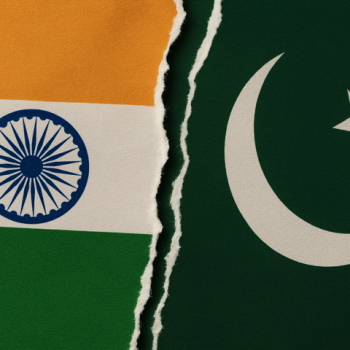by Amer Aziz
The world today makes many of us nervous. The American and Russian superpowers appear to be reenacting their geopolitical rivalry. A trade war is brewing between China and America. War, genocide and religious extremism have ravaged entire nations like Syria, Yemen and Myanmar.
But, there is hope– a new gospel (good news) is being preached: The Messiah has come. This is the message of The Ahmadiyya Muslim Community to the world.
A holy one, sent by God, is awaited by most adherents of the world’s religions today— one who will remove conflict and usher peace. That Messiah, we claim, is Mirza Ghulam Ahmad (1835-1908) of Qadian, India. Ahmad claimed to be the Promised Mahdi of the Muslims, the (allegorical) Second Coming for the Christians, the Kalki Avataar of the Hindus and the Maitreya (next coming) of the Buddhists.
Some find this to be very odd. How can religions with such profound differences in theology and doctrine be fundamentally connected and prophesizing the advent of the same future prophet? The Holy Quran states in chapter 16 verse 37: And We did raise among every people a Messenger, preaching: Worship Allah (God) and shun the Evil One.
Ahmad stated, “God has sent me into the world to remove the distance that has come between man and his Creation…and reveal the religious truths that have long remained hidden from mortal eyes”.
Indeed, there is exciting discovery opening up the idea of a common heritage of world religions. Here are two remarkable bonds between four great religions of the world seemingly at odds with each other.
Christianity and Buddhism
Christianity is associated with the western world (though it originated in the east), is deeply ingrained in the idea of salvation through the acceptance of Jesus Christ as God and savior, and has a great tradition of outreach. Buddhism, on the other hand is seen distinctly as an eastern religion, mysterious, deeply ascetic and inward with a weaker emphasis on an omnipotent God.
But that may not have been the case two thousand years ago when Jesus Christ lived and preached. Let us take a deeper look.
The Gospels tell us of the Magi— the three wise men following a star (astrological signs) to the place of Jesus’s birth. In the Gospel of Matthew verse 2:1 states that the Magi were men who came from the east. The gnostic Gospel of the Nazarene states the Magi were ‘foreigners’ and ‘dark of color’.
Amazingly, the tradition of the Magi survives to this day, not in Christianity, but in Buddhism! The Dalai Lama is similar to the pope for Tibetan Buddhists. Every time a Dalai Lama passes away, senior Buddhist monks undertake a wide search for a holy child who is then groomed to become the next leader of the community.
Several Indologist scholars, such as Sir Monier Williams and Herman Oldenberg, have written about the remarkable parallels between the accounts of Christ and Buddha in the Gospels and the Sutras (Buddhist holy books). For example, both Jesus and Buddha speak abundantly in parables many of which strike a similar theme, both give a sermon on a mount, they both undertake a forty-day fast and resist the temptations of the devil in the wilderness. Both travel widely with a band of disciples. Jesus routinely criticizes the Jewish temple priests immersed in ritual while devoid of spirituality. And Buddha too chastises the Brahmans for meaningless religious regulations.
Mirza Ghulam Ahmad explains this phenomenon in his book, Jesus in India— that several Buddhist scriptures, such as the Laggavatti Suttatta, mention the advent of a Buddha known as Bagwa Metteyya. In Sanskrit, Bagwa means white or fair-skinned, while Metteyya is a probable reference to Messiah. Ahmad stated that though Christian doctrine states that Jesus died and resurrected, he actually was in a near-death state when removed from the cross and revived in three days. Since he was now condemned under Roman law, he left Judea and the Roman Empire to seek out the lost tribes of the Israelites in East Asia. There he was accepted as the fulfilment of the Bagwa Metteyya prophecy by Buddhists who incorporated his teachings and stories into the Sutras; these later became attributed to Gautama Buddha, but really are those of Jesus Christ.
Islam and Hinduism
This throws a lot of people off kilter: How can the legacy of monotheism (Islam) be connected with a multiplicity of Gods (Hinduism)?
Well, just as shocking is the fact that there is a hadith (or saying) of Muhammad in a text known as the History of Hamadan Dailmi which states: There was a prophet of God in Hind (India), dark of color, and his name was Kahina. ‘Kahina’ here is a variant of ‘Kanaiyah’. Krishna is oft referred to by his followers as ‘Krishna Kanaiyah’. And vice versa, some believe Krishna foretold the advent of Muhammad. The Hindu scripture Bhavishya Purana speaks of a spiritual reformer named Mahamada who will appear in the desert, he will be illiterate, his followers will be meat-eaters and they will bring about a revolution and forge a great civilization—all which historically agrees with the biography of Muhammad.
Furthermore, another Hindu text known as Kalki Purana mentions the Kalki Avataar (future coming) during a time of a terribly dark force known as Kaali (Anti-Christ), the advent of the rivalry of Koka and Vikoka (Gog and Magog)—all of which agrees with Islamic (and Christian) eschatology.
Messiah
Ahmad emphasized that these great religions originally preached the unity of the one God of all mankind and the universe before developing in their own peculiar way. And, these scriptures are speaking of the same prophet or Messiah who will consolidate religion and ignite a spiritual reawakening in an era known in scripture as the Latter-Days, the Seventh Day or the Day of the Lord.












